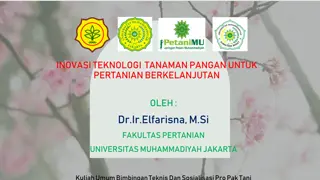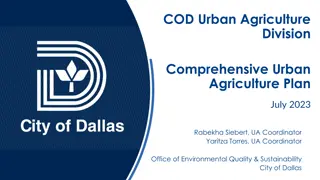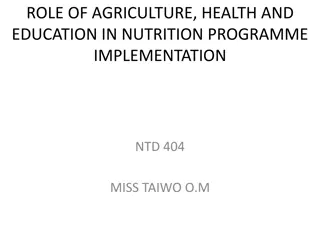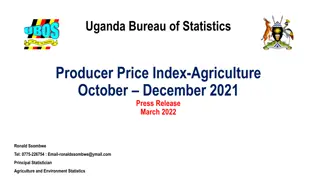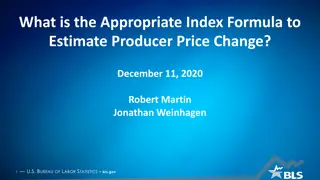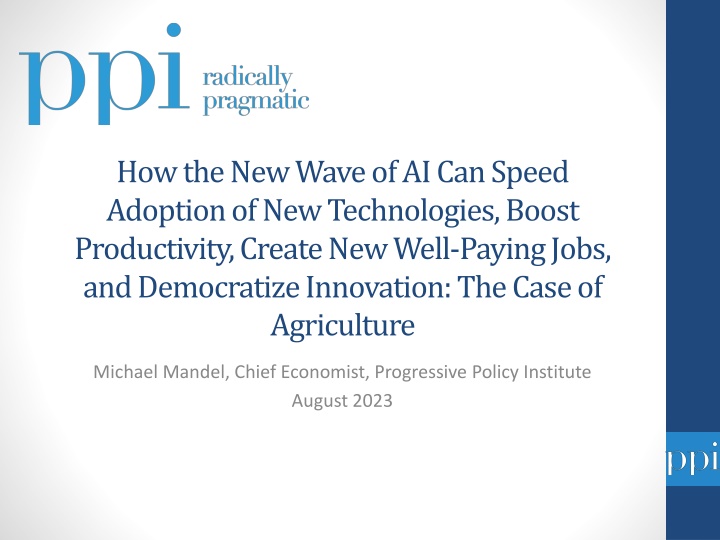
New Wave of AI in Agriculture: Boosting Productivity & Creating Jobs
"Explore how large language models can revolutionize agriculture, democratize innovation, and accelerate productivity growth, leading to job creation and economic revival in rural areas."
Download Presentation

Please find below an Image/Link to download the presentation.
The content on the website is provided AS IS for your information and personal use only. It may not be sold, licensed, or shared on other websites without obtaining consent from the author. If you encounter any issues during the download, it is possible that the publisher has removed the file from their server.
You are allowed to download the files provided on this website for personal or commercial use, subject to the condition that they are used lawfully. All files are the property of their respective owners.
The content on the website is provided AS IS for your information and personal use only. It may not be sold, licensed, or shared on other websites without obtaining consent from the author.
E N D
Presentation Transcript
How the New Wave of AI Can Speed Adoption of New Technologies, Boost Productivity, Create New Well-Paying Jobs, and Democratize Innovation: The Case of Agriculture Michael Mandel, Chief Economist, Progressive Policy Institute August 2023
Summary 1. People are worried that generative artificial intelligence (gAI)--and large language models (LLMs) in particular--will destroy jobs. 2. We propose that LLMs should be thought of as a General Purpose Adoption Technology (GPAT)with the ability to break down some of the barriers to innovation that have held back stagnant sectors such as agriculture and manufacturing. 3. The key is that LLMs are democratizing: They will allow small and medium enterprises (SMEs) to experiment with, adopt, and maintain new technologies such as machine learning and robots with less need to depend on expensive third-parties such as systems integrators. 4. To put it another way, today SMEs that want to digitize have to purchase scarce complementary inputs such as design, installation and maintenance expertise at a high price. LLMs lower the long-term cost of those complementary inputs, and make them more widely available.
Summary--2 5. The best analogy is the introduction of the personal computer. Previous to the PC, information technology applications were controlled by centralized IT staff. But the PC brought the IT revolution down to the level of SMEs and individual departments of large enterprises, and greatly accelerated the rate of adoption. 6. Because GPATs reduce dependence on expensive intermediaries, the new adoption technologies will accelerate diffusion, boost productivity, lower prices, and raise incomes. Mounting evidence also suggests that faster productivity growth could also bring more job creation. 7. Since 2007, sectors with faster productivity growth have added 2.2 million jobs, while sectors with slower or negative productivity growth have lost 1.2 million jobs. 8. The new diffusion technologies will aid a wide range of lagging industries, including manufacturing, construction, and food production.
Summary--3 9. In this study we will focus on agriculture, which has suffered from the unhappy combination of weak productivity growth for the past 20 years and no employment growth. The result has been rising food prices, stagnant farm incomes, and weak rural incomes. 10. We suggest that LLMs can accelerate the adoption of digital innovations on the farm (see Google s Mineral), while boosting productivity and incomes, creating jobs and reviving local rural economies. 11. We are already seeing applications of LLMs to agriculture, as the Farmers Business Network shows.c We conclude by suggesting that applying LLMs to farming may reduce regional disparities.
Structural Economic and Regional Problems 1. Currently about a third of the US economy has successfully adopted digital technologies to boost productivity growth (based on PPI analysis of industry productivity data). Some of these sectors are highlighted in Figure 1. 2. Heavy technology investments in management and administrative functions have produced significant productivity gains, as have IT investments in finance and insurance. 3. Two-thirds of the economy have experienced slowing or negative productivity growth. Some of these sectors are highlighted in Figure 2, including farming, manufacturing, construction, air transportation, and truck transportation. 4. Some have argued that this apparent productivity slowdown reflects measurement error. But recent careful economic research, including a paper by Austan Goolsbee and Chad Syverson (2023) on productivity in the construction industry, has tended to confirm the reality of the productivity slowdown. 5. Because industries are regionally concentrated, this disparity in industrial productivity growth is reflected in regional disparities.
Figure 1. Selected sectors with accelerating total factor productivity growth (average annual growth rate over period) 4.5% 4.0% 3.5% 3.0% 2.5% 2.0% 1.5% 1.0% 0.5% 0.0% Information Computer systems design Management of companies Administrative and support services Finance and insurance Oil and gas extraction -0.5% -1.0% 1987-2007 2007-2021
Figure 2. Selected Sectors with Slowing or Negative Total Factor Productivity Growth (average annual growth rate over period) 4.0% 3.0% 2.0% 1.0% 0.0% Crop & animal production (Farms) Mining, except oil and gas Durable manufacturing sector Nondurable manufacturing sector Construction Utilities Air Truck Accommodation and food services transportation transportation -1.0% -2.0% -3.0% 1987-2007 2007-2021
The Positive Association Between Productivity Gains and Job Growth 1. The six sectors with accelerating productivity growth in Figure 1 added 2.2 million jobs between 2007 and 2021. 2. The nine sectors with slowing or negative productivity growth in Figure 2 lost 1.2 million jobs between 2007 and 2021. 3. A more comprehensive analysis shows the same positive correlation between productivity growth and job growth. 4. Correlation is not causation. But it s clear that accelerating productivity growth is associated with expanding markets and rising employment. Slowing productivity growth is associated with stagnant markets and stagnant employment.
The Case of Retail/Ecommerce 1. Retail/ecommerce is a special case because the published data does not accurately represent the realities of the industry. The published data shows a fall in hours worked and very sluggish productivity growth in the retail sector. 2. We need to account for the 25% drop in household shopping hours since the early 2000s (see Mandel 2020). This unpaid hours have been shifted to paid hours in delivery and ecommerce fulfillment centers. 3. Delivery drivers and ecommerce fulfillment center workers now do the transport and picking and packing more efficiently than individuals once did. 4. The result is that the shift to ecommerce has boosted consumer distribution productivity and created new paid jobs at good wages.
Slow Technology Diffusion 1. Retail/ecommerce is important because it shows how robotics and machine learning can transform a stagnant physical industry and create new jobs. 2. Other stagnant industries, such as agriculture, manufacturing, construction and transportation, could follow the same path of digitization and job creation. But so far, diffusion of innovation has been slow and halting, despite mammoth investments by tech companies in cloud computing, machine learning, and artificial intelligence (see PPI Investment Heroes reports, various years). 3. There s a growing literature on the importance of slow technology diffusion for explaining our current economic problems (see, for example, Besson 2022). 4. How can we accelerate the pace of technology diffusion and adoption across the economy with the goal of boosting job and productivity growth?
The Cost of Adopting New Technologies 1. It s important to focus public discussion on lowering the barriers to adopting new technologies. 2. The current mechanism for diffusion and adoption of new technologies includes third party systems integrators and consultants, who play a necessary but expensive role. 3. These third parties provide the complementary inputs necessary to implement, adjust and maintain new technologies, at high prices. Complementary inputs refers to the expensive installation, design and maintenance expertise necessary to employ new technology. 4. Interviews with manufacturing SMEs suggest that their hesitancy to digitize stems in part from their unwillingness to be dependent to consultants and systems integrators who are not part of their company (Mandel 2018). 5. Repair and maintenance of new technologies is a big issue as well. Farmers who bought data-enabled Deere tractors found themselves at war with the company about right-to-repair.
Lowering the Cost of Adopting New Technologies 1. While we do not yet know what generative AI applications will arise, we suspect that gAI and LLMs in particular may be an important channel for diffusing job-creating innovation into stagnant sectors such as agriculture and manufacturing. 2. The key is that LLMs will allow small and medium enterprises (SMEs) to experiment with, adopt, and maintain new technologies such as machine learning and robots with less need to depend on expensive third-parties such as systems integrators and consultants. 3. The best analogy is the introduction of the personal computer. Before the PC, IT applications were controlled by centralized IT staff. But the PC brought the IT revolution down to the level of SMEs and individual departments of large enterprises, and greatly accelerated the rate of adoption. 4. The PC was a disruptive innovation in the sense that it was objectively less powerful than mainframes or minicomputers. But it was so much cheaper and more accessible that it unleashed creativity and innovation on a world-shaking scale.
LLMs as a General-Purpose Adoption Technology (GPAT) 1. Like PCs, LLMs are a disruptive technology. They produce objectively lower quality results than good systems integrators, software coders, data analysts, or consultants. 2. But using an LLM, once it is trained, is so much cheaper and easily available that it empowers experimentation and customization of other technologies, such as machine learning, machine vision, and robotics. 3. In this vein, we suggest that LLMs should be thought of as a general purpose adoption technology (GPAT). A GPAT lowers the cost of complementary inputs such as design, installation and maintenance expertise, making it easier for individuals and SMEs (and the equivalent units of large enterprises) to access capabilities that would otherwise be out of their grasp. 4. A GPAT should also reduce the cost of post-adoption adjustment, repair and maintenance. That is, as business conditions change, it shouldn t be necessary to hire expensive consultants to make changes in the equipment.
Using LLMs as a GPAT: The Case of Agriculture 1. We use agriculture as an example for several reasons. First, crop and animal production is easier to understand than either manufacturing or construction, with fewer possible measurement issues. 2. Second, farming productivity growth has fallen by more than half (Figure 3), even before the pandemic. The growth rate of corn yields has fallen by half (not shown). 3. Third, the slowdown in productivity growth has had a direct effect on consumers. Farm commodity prices started rising faster than consumer inflation well before the pandemic (Figure 4). 4. Fourth, in addition, the long-term decline in food s share of household budgets stalled in 2000, around the time when productivity growth stalled as well (Figure 5). 5. Fifth, the slowdown in productivity has not led to an increase in employment in the farm sector , which has fallen 17% since 2000 (Figure 6).
Figure 3. Farmland Productivity Has Slumped (farm total factor productivity, annual growth rate over period) 1.87% 2.00% 1.80% 1.59% 1.60% 1.46% 1.40% 1.20% 1.00% 0.66% 0.80% 0.60% 0.40% 0.20% 0.00% 1948-1973 1973-1990 1990-2000 2000-2019
Figure 4. Farm Prices Have Been Rising Faster than Inflation since 2000 (annual percent change in prices) 18.0% 16.0% 14.0% 12.0% 10.0% 8.0% 6.0% 4.0% 2.0% 0.0% 1948-1973 1973-1990 1990-2000 2000-2019 2019-2022 -2.0% -4.0% farm products* all consumer prices
Figure 5. The Long-Term Decline in Food Expenditures Stalls Since 2000 (food share of PCE) 30.0% 25.0% 20.0% 15.0% 10.0% 5.0% 0.0% Foo and beverages for off-premises consumption Food services All food and beverages
Figure 6. The Long-Term Decline in Farm Employment Continues After 2000 (thousands) 5,000 4,500 4,000 3,500 3,000 2,500 2,000 1,500 1,000 500 0 1948 1950 1952 1954 1956 1958 1960 1962 1964 1966 1968 1970 1972 1974 1976 1978 1980 1982 1984 1986 1988 1990 1992 1994 1996 1998 2000 2002 2004 2006 2008 2010 2012 2014 2016 2018 2020 Full-time equivalent farm employees self-employed farmers
What happened to the Farming IT Revolution? 1. The term precision farming dates back to the early 1990s, when the first on-the-go crop yield monitor was invented in Ames Iowa. In 1996, John Deere launched its GreenStar Precision Farming System. Their brochure predicted, Information is your new crop!" 2. Certainly technologies such as GPS, satellite mapping and field sensors were implemented with great vigor. We are all familiar with the photos of the farmers in their data-equipped tractors. 3. Farm investments in information technology equipment (Figure 7) and software (Figure 8) originally rose quickly. But then investment in IT equipment slowed, and investment in software dropped sharply. 4. Deere warred with farmers over data ownership and right-to- repair. Revenues from services , including presumably data services, came to only $283 million in 2022 out of
Figure 7. Capital stock of information processing equipment in the farm sector 80 70 60 billions of 2012 dollars 50 40 30 20 10 0 1990 1991 1992 1993 1994 1995 1996 1997 1998 1999 2000 2001 2002 2003 2004 2005 2006 2007 2008 2009 2010 2011 2012 2013 2014 2015 2016 2017 2018 2019 2020 2021
Figure 9. Capital stock of software in farm sector 0.500 0.450 0.400 0.350 billions of 20212 dollars 0.300 0.250 0.200 0.150 0.100 0.050 0.000 1990 1993 1996 1999 2002 2005 2008 2011 2014 2017 2020
What are the barriers to adoption of information technology innovation to agriculture? 1. Data quality is a problem. As one report noted The basic data needed for ML applications include sensor readings from the field, weather reports, and farm activity logs, but these are not always available or easy to locate. 2. The great variability of location-specific conditions among farms in the US and around the world is another issue. A model trained in one location may not be suited to another location without expensive adjustment and validation. 3. Training a new ML model for a specific farming environment or for a different crop can be complicated, time consuming and expensive. The problem is compounded by global warming and climate variability, which lowers the value of historical data. 4. Finally, farming is a low-margin, risky operation that cannot afford to become dependent on expensive complementary inputs.
The Advantage of LLMs as a General Purpose Adaption Technology for Agriculture 1. LLMs operate like an ag consultant in a box. They can produce cheap solutions that can easily be customized by the end user,, the farmer, without giving up any of their domain knowledge. 2. They address the biggest problem to adoption, the ability to experiment at small scale. Just like personal computers democratized the information revolution, LLMs will accelerate the spread of digital technologies to physical industries. 3. Already entrepreneurs around the world are applying LLM front ends to agricultural software and data. One notable example is in India, where Pratik Desai, founder of Titodi, an online farmer s market, has put together KissanGPT. 4. In the US, the Farmers Business Network has rolled out an early version of Norm, an AI advisor for farmers built on ChatGPT and FBN s proprietary data.
Regional and Distributional Implications of GPATs for Agriculture 1. Rural areas have suffered from the slow growth of farm productivity and farm incomes In addition, increased concentration in the food-processing industry has squeezed the prices paid to farmers while raising the prices charged to consumers. The top four firms in soybean processing, for example, account for 75% of the market, according to the latest figures from the Economic Census. 2. The slow growth of farm incomes has obvious political and social implications. Many rural counties have been left behind by economic growth, widening the gap between rural America and the coasts. 3. At the same time, the price of food to consumers has surged, widening economic disparities downstream.
Conclusion 1. LLMs as a GPAT can help bring the information revolution to Rural America, at a cost that actually helps farmers and surrounding areas. As Google s Mineral puts it: Growers face hundreds of decisions every season, yet current tools aren t equipping them to meet the challenges they face. Even though they use digital tools like sensors, spreadsheets, and GPS, their data is either siloed or doesn t fully represent agriculture s complexity. 3. The result: More local jobs, more diversity of crops, and more food to feed America and the rest of the world.
The Progressive Policy Institute is a catalyst for policy innovation and political reform based in Washington, D.C. Its mission is to create radically pragmatic ideas for moving beyond ideological and partisan deadlock. . For more information: mmandel@progressivepolicy.org www.progressivepolicy.org



